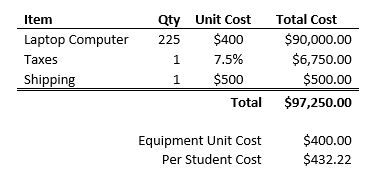Certain schools and libraries are being asked to reduce their Emergency Connectivity Fund (ECF) applications due to sales taxes and shipping charges. Rather than looking at the price of a device, the FCC is capping support for laptop and tablet computers at $400 per student (or library patron), inclusive of all other eligible stand-alone expenses. This is lowering the buying power of applicants, creating inequities, and reducing the efficacy of the ECF. The FCC can enforce a $400 price cap on the cost of devices, but applicants should not be forced to bundle other stand-alone expenses, like taxes and shipping, into the cost of that device.
***
The Emergency Connectivity Fund eligible services list provides support for five types of equipment:
- Wi-Fi hotspots
- Modems (e.g., air cards)
- Routers
- Devices that combine a modem and router
- Connected devices (laptop computers and tablet computers)
Two of the five items are subject to a per device funding cap. Wi-Fi hotspots are eligible for support up to $250 per device, and connected devices are eligible for support up to $400 per device. (These device price caps are in place because of concerns that the total demand for ECF support could outstrip the available funds.) The eligible services list makes clear that other items may be included with a device, such as a power cord, charger, and a multi-year warranty, so long as these items are not priced separately. The result of this is a straightforward concept: all equipment costs need to be bundled, and the support for this equipment will be capped at $250 or $400 per unit for Wi-Fi hotspots and connected devices, respectively.
In addition to equipment (and internet services), there are other stand-alone items listed on the eligible services list. These items are listed in a section titled “Miscellaneous”. These items are individually eligible for support and are not required to be bundled with equipment. Here is the full description taken directly from the list:
Installation, activation, and initial configuration costs, taxes, shipping charges, and other reasonable fees incurred with the purchase of the eligible equipment and services are eligible for support under the Emergency Connectivity Fund Program. – Eligible “Miscellaneous” ECF Charges
This means that other fees, such as taxes, qualify for ECF support and they do not have to be bundled into the cost of a device. The resultant framework can be summarized as follows:
- Equipment charges are capped and only bundled equipment items (i.e., those not priced separately) are eligible for support.
- Taxes, shipping, and certain other expenses are fully eligible as individual, stand alone, separately priced items.
This is where things get a little confusing. The FCC is instructing applicants that the cost of other expenses (like taxes and shipping) must be bundled into equipment charges – and that the new total cost must be below the equipment cap of $400.
Here is an example. Assume a school has 225 students who lack a connected device. The school gets a quote for a laptop computer that costs $400 per unit. The school decides to move forward with its order and there are other eligible expenses that are incurred for taxes and shipping. Assuming a 7.5% sales tax, and a $500 shipping fee, the total cost of the project would be $97,250.

Under the FCC’s current interpretation of the per device price cap, even though the laptop computer, including all bundled items, costs $400, this funding request would be considered over the ECF device cap because of the $432.22 cost per student.
***
The FCC does not require a cost allocation for items bundled with equipment. A power cord should never require a cost allocation. This makes sense and it is a fair way to administer the equipment price caps for hot spots and connected devices. But requiring that separate eligible, stand-alone fees be bundled into the equipment price cap is unfair. This practice will cost schools and libraries millions of dollars in support that could otherwise be used to serve students and library patrons.
***
Funds For Learning recommends that applicants submit all eligible expenses on their ECF applications. The price of a connected device should not exceed its relevant price cap and applicants should have the option to seek support for other eligible items that are not subject to the per device price cap.
